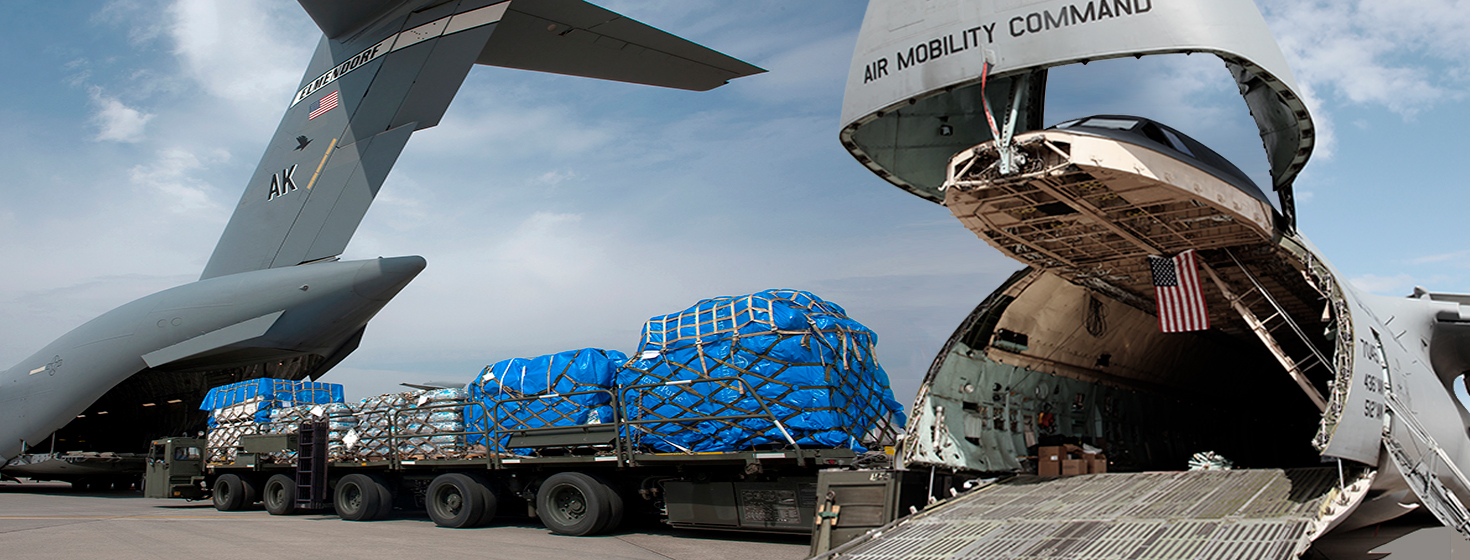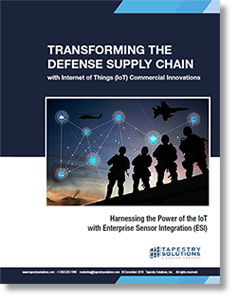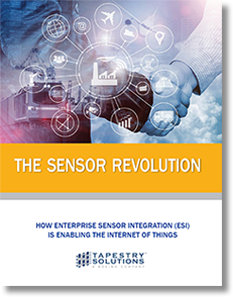Internet of Things (IoT)
Tapestry Solutions’ successful rollout of its Internet of Things (IoT) solution for enterprise-level manufacturing operations has garnered much attention over the past year.
At the recent RFID in Aerospace & Defense conference in Washington, D.C., attendees learned how the IoT software platform – dubbed Enterprise Sensor Integration (ESI) – also enhances military logistics and supply chain management.
As an event sponsor, Tapestry featured ESI at its exhibit and presentation, “Transforming A&D Supply Chains with IoT Sensor Integration.”
The session highlighted the deployment of ESI across major aerospace and defense companies, Boeing and BAE Systems, resulting in substantial cost savings due to increased productivity, asset visibility, and standardization.
Read the Article: BAE Systems Taps IoT Sensor Solutions to Boost Productivity
Pat Lubinski, Tapestry’s Business Development Director, discussed how ESI can help the military achieve total asset visibility and reduce costs across its supply chain.
Through data fusion, ESI integrates disparate sensor technologies – ranging from RFID and WiFi tags to embedded hardware and servers – to connect people data and processes across factories and supply chains.
The “sensor-agnostic” solution solves interoperability challenges caused by the proliferation of proprietary IoT devices and tracking solutions that cannot share data with other sensors or networks. ESI connects myriad of sensors and devices, regardless of brands or data formats.
The technology, in turn, provides the gateway to the IoT – an environment in which massive amounts of data is captured from a network of “things” – including sensors, software, electronics, and actuators – and turned into actionable insights to aid in the decision-making process.
ESI: Taking Asset Management to the Next Level
With its proven success in the commercial industry, ESI holds great potential for asset tracking, sustainment and supply chain operations in the defense sector.
At Boeing, ESI has interconnected nearly every aspect of the organization’s asset management and supply chain operations across more than 50 Boeing sites around the U.S.
The technology, proven to handle up to 6 billion RFID tag reads each week, saved Boeing more than $100 million in the first year alone.
At BAE Systems, Tapestry implemented an ESI-enabled RFID solution that has replaced existing manual processes with automation to effectively track and manage inventory, assets/tools, and work-in-process.
The technology enables automatic tracking of more than 200,000 assets, 30,000 parts, and about 6,500 work orders, providing standardization across its plants.
The IoT platform can also help military forces increase efficiencies, reduce costs and enhance situational awareness across its transportation and distribution networks.
The ultimate challenge for military logistics operations, however, is ensuring connectivity in the current fragmented network environment.
How an IoT Solution Can Benefit Military Supply Chains
An IoT-enabled, seamless supply chain can help the Department of Defense (DoD) achieve end-to-end asset visibility to ensure the right supplies are delivered to the right location at the right time.
This will ensure decision-makers have timely and accurate information on the location, condition, and status of critical supplies, ranging from equipment, weapons and spare parts to food, fuel, and medical supplies.
Although the DoD has made steady progress implementing RFID for asset tracking, it has not realized the full potential of the IoT – which also leverages automation and “Big Data” analytics – due to fragmented data sources.
The DoD has connected millions of sensors through extensive network infrastructures, including command-and-control systems, but these networks are developed independently with differing requirements and data formats.
As a result, information has to be passed manually between the stovepiped system, which is inefficient and subject to human error.
DoD: Leveraging Commercial IoT Advances
To keep pace with IoT advances and meet cost-reduction goals, the military is capitalizing on civilian IoT successes and lessons-learned to help manage the sheer volume of data produced for both tactical and logistics operations.
As part of its industry outreach efforts, the DoD actively engages with industry leaders, including participating in conferences such as RFID in Aerospace & Defense and RFID Journal Live, to keep abreast of the latest advances in automatic information technology and related IoT solutions, such as Enterprise Sensor Integration (ESI).
Note: The appearance of U.S. DoD visual information does not imply or constitute DoD endorsement.
Related Article: Tapestry Solutions Continues Support for U.S. Transportation Command SMS/CMS Mobility Systems
Related Papers & Case Studies
Transforming the Defense Supply Chain with Internet of Things Commercial Innovations New!
Learn why the estimated $19 trillion Internet of Things (IoT) market is quickly evolving, creating both opportunities and challenges for commercial and defense industries. Download Now!
How Enterprise Sensor Integration Is Enabling the Internet of Things
This white paper details how Tapestry Solutions, Inc. has addressed the IoT challenges with its Enterprise Sensor Integration (ESI) technology, ESI is an innovative integration platform that connects disparate sensor technologies. Download Now!
More Tapestry Solutions Resources
Article topics
Email Sign Up





















